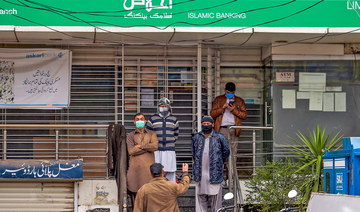RIYADH: Global industries must halve emissions by the end of this decade to reach 2050 net-zero targets, according to a new analysis urging for increased clean energy infrastructure spending.
In its latest report, compiled in association with BAE Systems, US-based consultancy firm Oliver Wyman emphasized the urgency of preserving clean water, stopping deforestation, and protecting nearly 1 million threatened species to safeguard the planet.
The UN has set ambitious climate targets, including reducing global emissions by 45 percent by 2030 and achieving net-zero emissions by 2050, in line with the Paris Agreement’s goal of limiting global warming to 1.5 degrees Celsius above pre-industrial levels.
Governments, particularly major emitters, are called upon to significantly enhance their Nationally Determined Contributions and take immediate, decisive actions to curb emissions, as outlined by the UN.
Underlining the importance of acting swiftly, the Oliver Wyman report said: “To avoid the worst impacts of climate change and ecosystem degradation, we must cut global emissions in half, halt and reverse nature loss, and achieve climate resilience by the end of this decade.”
It added: “The scale of this challenge is monumental. It requires the wholesale reallocation of capital from brown to green, the transformation of assets and supply chains from climate-vulnerable to climate-resilient, and the protection and restoration of ecosystems on a global scale.”
The report disclosed that just 1 percent — equivalent to $27 billion — of today’s $2.7 trillion annual infrastructure investment is climate-resilient.
“By 2030, that $27 billion needs to have grown to $6.9 trillion. In the same period, investment in nature-based solutions must triple to $400 billion a year,” said the consulting firm.
Supply chain resilience and sustainability
The report indicates that climate-related supply chain disruptions are increasing globally, yet most firms lack the tools to analyze and manage these rapidly evolving remote risks.
Oliver Wyman also pointed out that many companies have inadequate visibility into their supply chains and struggle to identify and mitigate vulnerabilities.
“As many as 85 percent of chief procurement officers are unable to evaluate risks beyond their first-tier suppliers, resulting in significant blind spots,” said the consulting firm.
It added: “Companies typically attribute over 90 percent of their physical climate risk exposure to direct operations and less than 10 percent to their supply chains, where in reality most of their material disruption risks reside.”
The study further highlighted that the implementation of AI and remote sensing will transform this landscape, enabling companies to monitor and identify the environmental impact of their material suppliers and dependent infrastructure.
Moreover, these technologies will allow risk managers and chief procurement officers to analyze data comprehensively, pinpoint their companies’ key strategic exposures, and assess disruption risks, thereby enabling them to address critical vulnerabilities effectively.
“Companies can begin to monitor their suppliers in real-time, anticipate disruptions, and make informed decisions about how to restructure supply chains to minimize risk,” the report highlighted.
Earlier this month, another report from the International Energy Agency highlighted the crucial role advanced technologies will play in transitioning to more secure and sustainable energy systems.
The IEA analysis also noted that the pace of deploying digital technologies in the energy sector will depend heavily on the ability to build a workforce with the right skills.
Furthermore, the think tank revealed that advanced technologies have the potential to enhance energy efficiency, reliability, connectivity, and reduce emissions.
Prioritizing sustainable financing
The Oliver Wyman report emphasizes that companies should categorize their supply chain activities into sustainable and unsustainable operations. This approach provides a clearer understanding of the environmental impact in different areas.
“With this disaggregated, near real-time view of a corporation’s environmental footprint and physical risk exposure, capital providers will be able to more confidently target sustainable finance toward climate-resilient green projects in brown sectors,” said the report.
Furthermore, this practice will incentivize transition without starving high-carbon sectors of capital.
In addition, insurers and banks will gain a comprehensive view of a company’s physical risk exposures across its operations, enabling them to develop customized risk management solutions for critical vulnerabilities.
The report also underscores that transitioning to a net-zero, climate-resilient future is not only an existential necessity but also a significant opportunity to reshape the global economy.
“Trillions of dollars a year of investment is needed — in low-carbon technologies and infrastructure, nature-based solutions, resilient supply chains, and new business models,” said the consulting firm.
It added: “Companies and financial institutions better able to quantify environmental risks and reliably assess how investment opportunities align with transition objectives will have a distinct advantage.”
Last year, consultancy firm Wood Mackenzie released a report stating that global annual investments of $2.7 trillion are necessary to achieve net-zero emissions by 2050 and prevent temperatures from rising above 1.5 degrees Celsius this century.
The report emphasized that renewable energy sources such as wind and solar power must become the world’s primary sources of electricity to support the electrification of transport and the production of green hydrogen.
In April, the IEA highlighted the need to scale up battery production to meet climate and energy security objectives set during the UN COP28 summit held in the UAE last year.
At the event, nearly 200 countries agreed to triple global renewable energy capacity by 2030, accelerate energy efficiency improvements, and transition away from fossil fuels.
The report also specified that achieving this goal would require deploying 1,500 gigawatts of battery storage by the end of this decade to support the expanded renewable energy capacity.
























